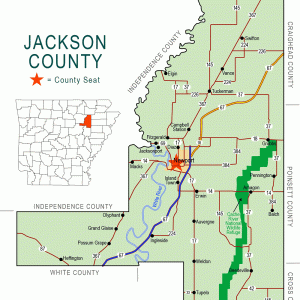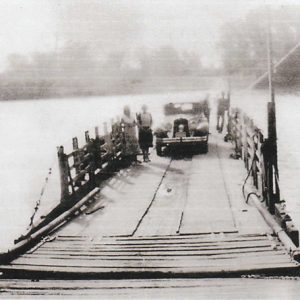calsfoundation@cals.org
Possum Grape (Jackson County)
Possum Grape is an unincorporated community in Glaize Township located in the western panhandle of Jackson County near Highway 367, about eleven and a half miles southwest of Newport, the county seat, and about four and a half miles northeast of Bradford (White County). Possum Grape lies just west of the White River where the flat land meets the Ozark Mountains. Possum Grape is near the historic riverboat town of Grand Glaise (Jackson County). The community most likely received its unusual name from the wild grape called the possum grape, popular in the area for making jam and wine. A few locals say Possum Grape was named in 1954 following a disagreement on whether to call it “Possum” or “Grape.” A compromise was supposedly worked out, and the two names were combined.
Before the Civil War, Grand Glaise (originally spelled Grand Glaize or Glaze), a river port on the White River, was the leading community in the area and the second-largest town in the county. The Patterson Ferry, owned and operated by James H. Patterson, crossed the White River at that point. Those who lived in what became Possum Grape prospered during the riverboat days. Grand Glaise played an active role in the Civil War because of its strategic location on the river. Confrontations between Union and Confederate soldiers, such as the Skirmish at Stewart’s Plantation, took place in the area, which was on a main route for troops to travel from Jacksonport (Jackson County) to Searcy (White County).
Significant post–Civil War developments such as a decline in riverboat trade decreased the importance of Grand Glaise and the surrounding area. The most severe blow was the construction of the Cairo and Fulton Railroad in the early 1870s, bypassing Grand Glaise for higher ground.
A post office with Edwin B. Califf as postmaster was established at what was then called Grand Glaize in 1851. In 1869, the post office was briefly discontinued, and then it was permanently moved in 1874 and reopened as Grand Glaise in 1887. It eventually became a part of the Possum Grape Mercantile Store until the post office closed in 1967.
For a time, the Possum Grape economy was spurred by the pearling industry, which involved diving for mussel shells in White River and selling them to the button factory in nearby Newport. From 1900 to 1920, the U.S. freshwater pearl market was centered at Newport, with the industry peaking in the 1930s and then declining due to production of plastic buttons.
References to the community as Possum Grape emerge in the early twentieth century. An article in the November 21, 1929, Batesville Guard noted that one Bryson Bursott of Bradford was owner of the Possum Grape Inn. A 1941 list of county home demonstration clubs included one in Possum Grape. The construction of U.S. Highway 67 in the late 1920s bypassed Grand Glaise but provided a boost for the emerging community of Possum Grape. However, U.S. 67 was later relocated further east, away from Possum Grape, and the older highway was re-designated Arkansas Highway 367.
The Possum Grape economy was aided when the Arkansas General Assembly designated Highway 67 as the Rock ‘n’ Roll Highway to honor the rockabilly music that blossomed in the clubs of Newport and Tuckerman (Jackson County) during the 1950s and 1960s. Possum Grape had its own club during this time, first called GB’s after its owner Gene Bryan Kennedy; it was later known as the Lamplighter Club.
In addition to the club, Mary Wilmans’ 67 Liquor Store served four adjacent dry counties. Possum Grape Mercantile, which served as the post office for Possum Grape (with a Grand Glaise address), was a general store where one could barter, trade, or buy; it was operated for many years by Walt and Irene Waring, with Irene serving as the official postmaster for Grand Glaise from 1947 until the post office was discontinued in 1967. The mercantile served as the center of the community, which consisted of about thirty houses.
Farming has been the main occupation for the inhabitants of Possum Grape, with a prevalence of truck-farming patches and tracts of cotton; in the twenty-first century, grain crops, mainly soybeans, in the fertile White River bottoms dominate the area’s economy. Devastating floods are common in the area. Locals often refer to the bottoms as “the land of cotton, soybeans, and mosquitoes.”
In the twenty-first century, the 67 Liquor Store, the Possum Grape Upholstery Shop, and a convenience store (across the highway from the site of the old store, which is no longer standing) are the only businesses in Possum Grape. Most school-age children who live in Possum Grape attend the Bradford public schools. The main burial site for the community is the Coffeyville Cemetery, with the Possum Grape Church of Christ remaining active in the twenty-first century.
For additional information:
Hanley, Ray. Images of America: A Journey through Arkansas, Historic U.S. Highway 67. Charleston, SC: Arcadia Publishing, 1999.
Harris, William. “The White River Monster of Jackson County, Arkansas: A Historical Summary of Oral and Popular Growth and Change in a Legend.” Mid-South Folklore 5 (Spring 1977): 3–23
Lance, Charles. “River Rats Call It ‘Old Grand Glaise.’” Arkansas Democrat, July 4, 1957, p. 3.
Morgan, James Logan, ed. Centennial History of Newport, Arkansas 1875–1975. Newport, AR: Jackson County Historical Society, 1975.
Morgan, Sam. “A History of Grand Glaize.” Stream of History 28 (Fall 1991): 2–10.
Shiras, Tom. “Grand Old Glaise Was One of the Best Ports on Lower White Now Is Forgotten Village.” Arkansas Gazette, September 9, 1935.
Shoults, Lenore. “Mother-of-Pearls: The Entwined History of Shell and Pearl in Arkansas.” PhD diss., Arkansas State University, 2010.
Kenneth Rorie
Van Buren, Arkansas
 Jackson County Map
Jackson County Map  Possum Grape Mercantile
Possum Grape Mercantile  White River Ferry
White River Ferry 



The post office was in the front room of Walt and Irene Warring’s house, which was located by the railroad. They did not own the store. It was owned by Allie Bryant for years, then by Gene & Rita Lingo and briefly by Jerry Masters.